⚠️ Did you receive an email claiming that your operating system has been hacked and demanding a ransom?
Question: Is this email legitimate?
Investigation Findings: This email is a scam. It typically says something like:
Hi.
This is the last warning.
I hacked your operating system.
All personal data from your devices has been copied to my servers.
I have access to your messengers, social networks, emails, chat history, and contact list.
My virus constantly updates signatures (it is driver-based) so it remains invisible to antivirus software.
While collecting information about you, I found out that you are a big fan of adult websites. You really like to visit porn sites and watch dirty videos while having an orgasm.
I’ve already made a screen capture. It’s a montage of the pornographic video you were watching at the time and your masturbation. Your face is perfectly visible. I don’t think this kind of content will have a positive impact on your reputation.
I can send this video to everyone who knows you. I also have no problem with making all of your personal information public on the Internet. I think you know what I mean.
It would be a real disaster for you. I could ruin your life forever. I think you really don’t want that to happen.
Let’s solve it this way: you transfer me 1200 dollars (USD) (in bitcoin equivalent at the exchange rate at the moment of funds transfer), and I will immediately remove all this dirt from my servers. After that, we will forget about each other.
My bitcoin wallet for payment: bc1q7df546x5cjj9fhlzczru5wvg86mltnfv3lvg5d
If you do not know how to transfer money and what Bitcoin is, use Google.
I give you 2 working days to transfer the money. The timer started automatically as soon as you opened the email. I’ll receive a notification about the opening of this email.
This email is designed to scare you into paying a ransom. The claims of hacking and having compromising information are false, and the threats are baseless.
Answer: The emails claiming your operating system has been hacked and demanding a ransom in Bitcoin are fraudulent. Do not respond, do not pay any money, and do not click on any links or attachments. Change your passwords, enable two-factor authentication, run a full antivirus scan, and report the email to your email provider and local authorities.
Table of Contents
🚨 Is the ‘This is the last warning’ Email a Scam?
Yes, the email claiming that your operating system has been hacked, your personal data copied, and threatening to expose compromising information unless you pay $1200 in Bitcoin is definitely a scam. 🚫 If you’ve received such an email, exercise extreme caution. The claims are fabricated and designed to instill urgency, misleading you into paying money to the scammer.
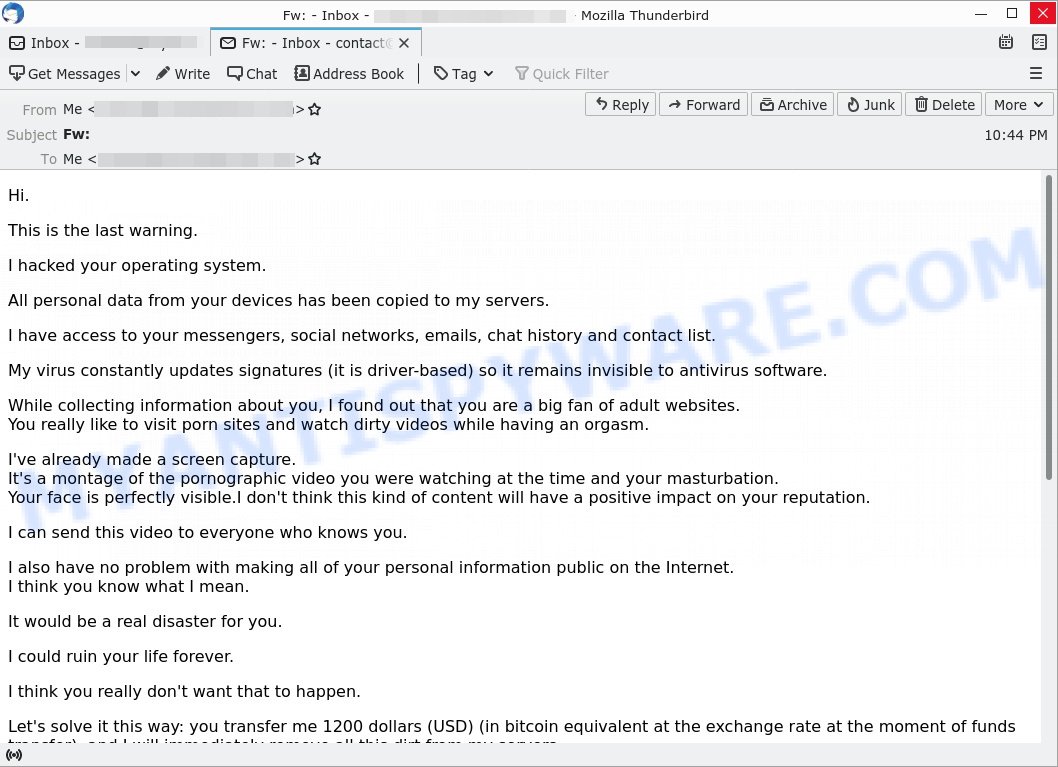
Background on the ‘This is the last warning’ Email Scam:
This scam involves fraudsters sending emails that claim they have hacked your computer and recorded compromising footage of you. The scammers demand a ransom in Bitcoin to prevent the release of this alleged footage.
However, legitimate cybersecurity experts and organizations confirm that these claims are baseless. No real hacking has occurred; the email is designed to scare you into paying the ransom. Scammers often send these emails in bulk, hoping to catch unsuspecting victims.
The alarming spread of these scams has prompted various government and consumer protection agencies, including the FBI and the Better Business Bureau, to issue warnings. These agencies have reported that these scams have been widespread, using similar tactics to exploit individuals’ fears of privacy invasion and public embarrassment.
The fraudulent emails often claim they have installed malware on your device and threaten to share embarrassing footage unless you pay. They provide a Bitcoin wallet address for the payment and set a deadline to increase the urgency and pressure.
🚩 Red Flags to Watch Out For:
To protect yourself, be aware of these warning signs of the scam: 🔍🛡️
- 📧 Unsolicited Threats: Unexpected emails that claim your device has been hacked and demand payment to prevent the release of compromising information.
- 💸 Ransom Demands: The scam includes demands for payment in Bitcoin, claiming it is the only way to prevent the release of the alleged footage.
- ⏳ Urgency and Imposed Deadlines: These emails impose a tight deadline to pressure you into acting hastily, using fear of embarrassment or reputational damage to coerce you into paying immediately.
- 🔄 No Evidence of Hacking: The email provides no real evidence that your device has been hacked or that any compromising footage exists.
- 👤 Anonymity of the Sender: Scammers use anonymous email addresses and provide untraceable Bitcoin wallet addresses, making it difficult to verify the source.
- 🔗 Suspicious Claims: Be skeptical of any email that makes extraordinary claims about hacking and demands for money.
Understanding the ‘This is the last warning’ Email Scam
If you receive an email that says “This is the last warning“, it’s normal to be alarmed 🚨. These emails typically start with frightening statements to grab your attention immediately. You might think, “How could they access my devices?” In reality, the sender doesn’t have any access to your personal information; their goal is to intimidate you into acting hastily.
These emails include baseless threats, claiming they have videos or other compromising information that could humiliate you 🎥. The wording is intentionally vague and menacing, crafted to make you feel uneasy: “Could any of this actually be true?”
The scammer may claim they’ve installed sophisticated malware, like spyware, on your device, purporting to have the ability to monitor all your online activities 💻. A clear sign this is a scam is the lack of any concrete evidence 🚩. They use the threat of high-tech surveillance to frighten you, not genuine hacking abilities.
The email typically concludes with a request for a payment 💰, with the scammer demanding a ransom in Bitcoin because it’s difficult to track. The scam is orchestrated to coerce you into paying swiftly. However, making a payment doesn’t guarantee your safety and may even mark you for further scams.
Upon reading the email, you might question, “Am I truly in danger?” or “Can this individual actually do what they claim?“. Generally, these threats are fictitious; they are merely exploiting your fears.
What should you do? It’s advisable not to respond to the scammer or send any money. Concentrate on securing your online presence: update your passwords, ensure your devices are protected, and consider reporting to the police if the scam involves threats or extortion 🔐. Such incidents underscore the importance of vigilance and proactive online security measures.
Essentially, this scam relies on instilling fear and urgency to deceive you. If you receive an email like this, do not engage with the scammer or transfer any money. Simply delete the email. Also, keep your computer safeguarded with up-to-date anti-virus software, and use strong, unique passwords for all your accounts to help prevent falling victim to such scams.
Examples of such scams
Scammers have developed a variety of tactics to intimidate and exploit unsuspecting individuals. Here are a few common examples:
💼 I am a professional hacker EMAIL SCAM
Posing as a hacker, the sender of this email might say they’ve infiltrated your system. They may even claim they have proof of embarrassing activity and will publish it unless you send them money. Remember, a real hacker wouldn’t announce their presence—it’s a tactic to pressure you into paying.
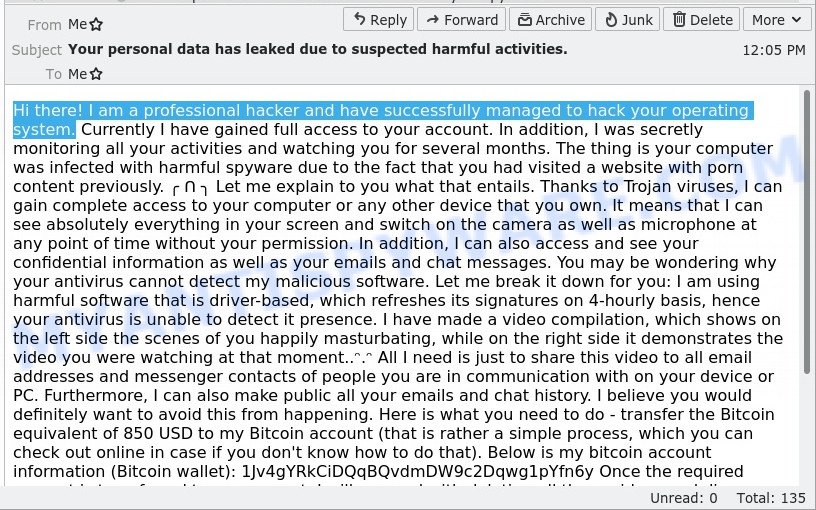
🔒 Your Private Information has been Stolen Email Scam
Here, the scammer will claim they’ve stolen sensitive information from you and threaten to release it unless you pay a ransom. They rely on the scare factor, hoping you’ll pay to protect your reputation, even though they likely have no data at all.
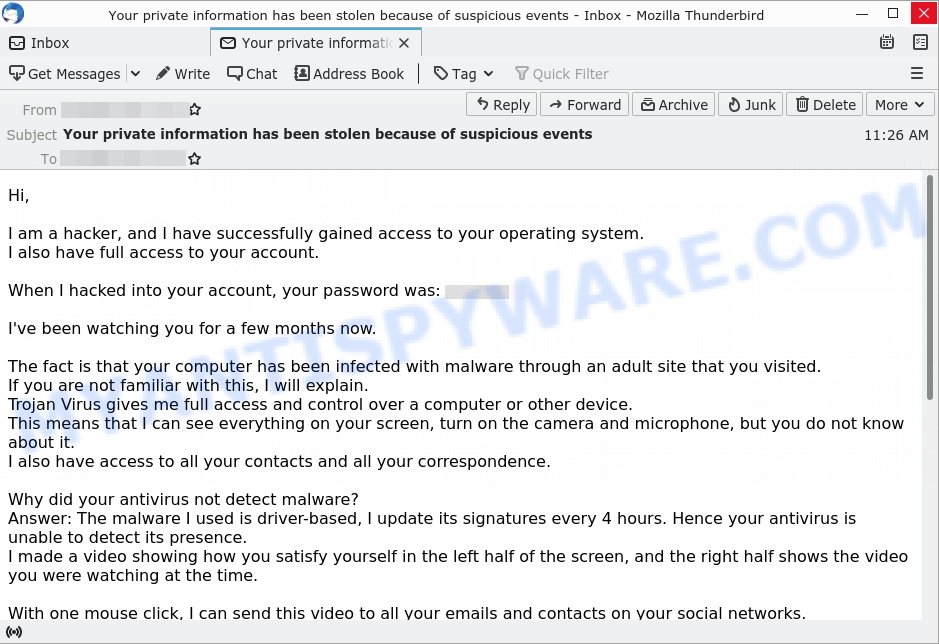
📹 I RECORDED YOU Email Scam
In this scam, the sender claims to have control over your camera and alleges they have recorded you during private moments. They typically demand payment to keep the footage private. Beware: this is a bluff to get you to pay up out of fear.
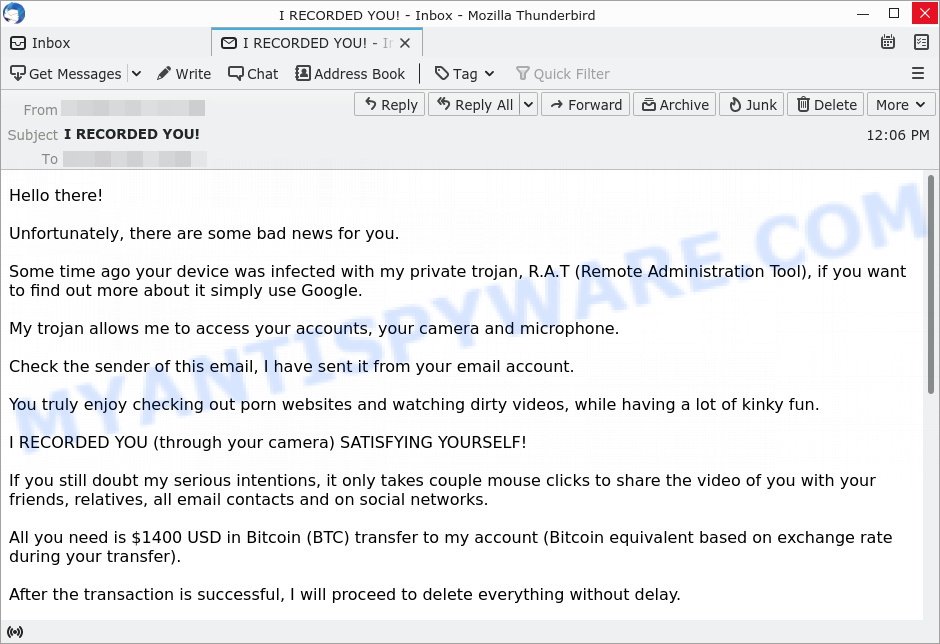
Each of these scams plays on fear and urgency to trick you into acting against your best interest. Always approach such emails with skepticism, verify your security, and do not engage with the scammers.
Should you send the money?
No, don’t give the scammer any money. It’s a scam, and giving them money will only encourage them to continue their criminal activities. Plus, if you pay once, they might target you again. To keep your personal information safe, always use strong and unique passwords for each of your accounts, enable two-factor authentication for an extra layer of security, and keep your computer’s antivirus software up to date. If you receive an email like this, it’s important to report it to the authorities and your email provider.
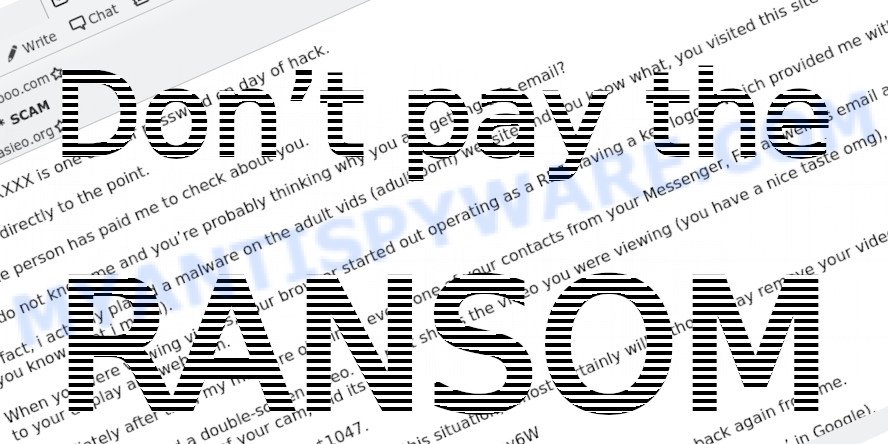
What to Do if You Get This Scam Email
Getting an email that says someone hacked your devices and has compromising information can be scary, but there are easy and safe ways to handle it.

Here’s what to do:
First, stay calm. The email is meant to scare you and make you act without thinking. Remember, it’s just a scam to make you feel afraid.
Don’t pay them. Paying won’t make the problem go away. It only shows the scammer that you are an easy target for future scams.
Don’t reply to the scammer. Responding can give them more information about you and confirm that your email is active, which could lead to more scams.
If the email mentions a password you recognize, check where it came from. Use sites like haveibeenpwned.com to see if your email or passwords have been part of a data breach.
Then, change your passwords. Use strong, unique passwords and set up two-factor authentication where you can.
For safety, run a full security scan on your device. The email’s claims about malware are usually false, but it’s good to make sure your system is clean.
Report the email to the authorities (like the FTC). Reporting helps with investigations and can stop these scams from happening to others.
Finally, tell others. Let your friends, family, and coworkers know about this scam so they can avoid it too. Sharing this information makes everyone safer.
Threat Summary
| Name | ‘This is the last warning’ Email Scam |
| Type | Phishing/Sextortion |
| Ransom amount | $1200 USD (in Bitcoin equivalent) |
| Bitcoin Address | bc1q7df546x5cjj9fhlzczru5wvg86mltnfv3lvg5d |
| Fake Claims | Access to personal data and browsing history, control over messengers and social networks, possession of embarrassing videos |
| Damage | Psychological distress, potential financial loss if ransom is paid |
| Distribution | Mass emailing, likely from a purchased or hacked email list |
| Tactics | Inducing fear, creating urgency, deceptive claims |
| Variations | Different ransom amounts, varying email content, alternative cryptocurrencies for payment |
| Prevention Tips | Use strong, unique passwords; enable two-factor authentication; be skeptical of unsolicited emails; never pay ransoms |
| Reporting Info | Forward to the Anti-Phishing Working Group at reportphishing@apwg.org; Report the scam to relevant authorities (e.g., FTC); Share information about the scam with friends and family to raise awareness; Monitor online accounts for any suspicious activity |
Conclusion
The “This is the last warning” email is a typical sextortion scam that uses fear to try to get money from you. The scammer claims they’ve taken over your devices, copied your personal data, and recorded you during private moments, threatening to share these supposed recordings unless you pay a ransom in Bitcoin. Remember, these threats are fake, designed to scare you into paying.
Bottom Line: Ignore these emails. The best way to protect yourself is to not engage with the sender and to upgrade your device security. 🛡️💻
Stay sharp and think critically; an email that triggers fear or seems overly complex is probably a scam. 🤔
















